16
Writing Letters and Memos
Good communication is good business. This has been true throughout history. Well-written letters and memos help your business serve its clients well—to everyone’s benefit.
When sending letters or distributing memos, your goal is for your reader to understand and respond to your message as planned. You also want to initiate or maintain a good working relationship. In other words, you want results. If you write messages that are clear, complete, and focused on your reader, you will get results.
In this chapter
Guidelines Writing Letters
In a letter, your goal is to communicate your message and give a positive impression of yourself and your organization.
-
Plan: (Ideas and Organization)
-
Ask yourself what you want the letter to accomplish.
-
Consider the reader’s concerns about, knowledge of, and history with your organization.
Gather information.
-
Gather files and other necessary resources.
-
Jot down your main points in a logical order.
-
Use the letter format (full-block, semiblock, or simplified) that your company prefers.
-
-
Draft: (Ideas, Organization, and Voice)
Opening State the situation (reason for writing, background).
Middle Give the full explanation, supporting points, and details. If your message is informative, make your key point early. For a bad-news or persuasive message, build up to the main point.
Closing End with a call to action (who should do what, when), and, if appropriate, mention future contact.
-
Revise: (Ideas, Organization, Voice, Words, and Sentences)
-
Are all names, dates, and details accurate?
-
Is information presented in a logical order?
-
Do you use a conversational but professional tone?
-
Do you emphasize the reader’s perspective?
-
Have you used precise wording?
-
Have you used personal pronouns in a positive way?
-
Do you have smooth sentences that pass the “read aloud” test?
-
-
Edit: (Conventions and Design)
-
Have you checked spelling (especially double-checked names)?
-
Have you checked grammar, punctuation, and mechanics?
-
Have you checked format and design?
-
“Be yourself when you write. You will stand out as a real person among robots.”
—William Zinsser
Professional Appearance of Letters
Before your readers catch a word of your message, they’ve already read your letter’s overall appearance. What does it say to them? Use the guidelines on this page to ensure a good impression.
First Impressions
Choose your look.
Do you want your letter format to look traditional and conservative or friendly and contemporary?
Frame your letter in white space.
Make your margins 1 to 1.5 inches left and right, top and bottom. Create a balanced, open look by centering the message vertically and adjusting the space between the parts of the letter.
Make reading easy.
Use sensible type sizes and styles.
-
Keep type size at 10–12 points.
-
Choose a user-friendly font. Serif type has fine lines finishing off the main strokes of the letter. (This is serif type.) Sans serif type has a block-letter look. (This is sans serif type.) Serif typefaces are easier to read and understand; sans serif typefaces work well for headings.
-
Avoid flashy and frequent type changes, as well as overuse of italics or boldface.
Print for quality.
Use a quality printer and avoid any handwritten editing changes. Always print a clean final copy.
Letter Perfect
Use 20- to 24-pound bond paper.
The 20- to 24-pound bond paper folds cleanly, takes ink crisply, and works well in most printers.
Use 8.5- by 11-inch paper.
It’s standard and files easily. Other sizes may be used for personal correspondence, executive letters, or mass mailings.
Use white or off-white paper.
Be careful with other colors. Light, subtle colors mean business. Bold colors scream, “I’m an ad!”
Match, don’t mix.
Letterhead pages, continuation sheets, and envelopes should match in paper weight, size, color, and design.
Letterhead Design
If you are asked to design or redesign your company’s letterhead stationery—or if you want to design a letterhead specific to your position—be sure to include the following:
-
the company’s complete legal name;
-
the company logo or slogan;
-
complete contact information—full mailing address, phone number (including area code), a fax number, and website address.
-
names of key people (perhaps in the left-margin sidebar).
Note: Make sure your design reflects your company’s mission and character.
Parts of a Basic Letter
All letters should include a clear message and information about the writer and the reader. Details for basic and expanded formats follow.
Basic Letter Tips
-
Do not indent paragraphs.
-
Single-space within paragraphs.
-
Double-space between paragraphs.
-
Leave the right margin ragged (uneven).
-
Set margins from 1 to 1.5 inches.
-
The heading provides the reader a return address. Type the address (minus the writer’s name) at the top of the letter. Spell out words like Road, Street, West. Omit the address if you are using a letterhead.
-
The date shows when the letter was drafted or dictated. Write the date as month, day, year for U.S. correspondence (August 5, 2019); write day, month, year for international or military correspondence (5 August 2019).
-
The inside address gives the reader’s name and complete mailing address. Type it flush left and include as many details as necessary, in this order:
-
reader’s courtesy title, name, and job title (if the job title is one word)
-
reader’s job title (if two or more words)
-
office or department
-
organization name
-
street address/p.o. box/suite/room (comma precedes NE, SE, etc.)
-
city, state, zip code (or city, country, postal code)
-
-
The salutation personalizes the message. Capitalize all first letters and place a colon after the name. (See “Forms of Address.”)
-
The body contains the message, usually organized into three parts:
-
an opening that states why you are writing,
-
a middle that gives readers the details they need, and
-
a closing that focuses on what should happen next.
-
-
The complimentary closing provides a polite word or phrase to end the message. Capitalize the first word only and add a comma after the closing.
-
The signature block makes the letter official. Align the writer’s name with the complimentary closing. Place a one-word job title on the same line as the typed name or below the name; place a longer title below the typed name.
-
Use an enclosure note whenever you enclose something. Type Enclosure(s) or Enc(s). and the number of enclosures. To list enclosures by name, type Enclosure(s) or Enc(s)., a colon, and the names stacked vertically.
-
A postscript contains a personal or final note. Type P.S. (with periods but no colon) followed by the message.
Writing Basic Letters
R & J Law Office
105 East Bay Road
Bar Harbor, ME 04609-6327
August 5, 2019
Two to Eight Spaces
Ms. Abigail Bruins, Manager
Rena’s Restaurant
3706 Chamberlain Avenue, SE
Bar Harbor, ME 04609-3427
Double Space
Dear Ms. Bruins:
Double Space
Early last week, we received your letter, along with a drawing of the deck that you want to add to the east side of your restaurant. Opening In that letter, you described your building plan and asked that one of our attorneys advise you on how to proceed.
Middle I studied the plan and found it attractive. However, the drawing shows that the east edge of the proposed deck would extend within six feet of your side property line, thereby violating Article X in the city’s building code. That article requires ten feet between a building and a side property line. (I have enclosed a copy of Article X.)
Closing Given this restriction, you could proceed with your building plan in one of two ways: (1) present your plan to the Planning and Zoning Commission and ask for a variance to Article X, or (2) adapt the plan so that it conforms to the code. Please call me at 217-555-0654 to discuss this matter.
Double Space
Yours sincerely,

Four Spaces
Sydney George
Attorney-at-Law
Double Space
Enclosures:
1. Drawing
2. Article
Parts of an Expanded Letter
Adding Information
When you, your reader, a typist, a filing clerk, or future readers need additional information, include one or more of the items from this list.
-
A method of transmission note indicates how a letter should be or has been sent: via facsimile, via registered mail, via overnight courier.
-
A reference line begins with a guide word and a colon (Reference:, In reply to:) followed by a file, an account, an invoice, or a database number.
-
When appropriate, use a confidential notation on both the letter and the envelope. CAPITALIZE or underline the word confidential for emphasis.
-
In the inside address, stack names by alphabet or position for two or more readers. For two readers at separate addresses, stack the addresses (including names) with a line between.
-
The attention line designates a reader or department but encourages others to read the letter. Place it two lines below the inside address, flush left or centered. CAPITALIZE or underline for emphasis.
-
The subject line announces the topic and is placed flush left two lines below the salutation. CAPITALIZE or underline for emphasis.
-
The signature block may include the writer’s courtesy title typed in front of the name to clarify his or her gender or a preferred form of address. If two people must sign the letter, place the second name beside the first starting at the center of the page—or place it four spaces below the first name.
-
In the identification line, type the writer’s initials in capitals and the typist’s in lowercase, separated by a slash (but no spaces).
-
Use the copies notation by typing c or cc, followed by a colon and a vertical list of people (with job titles in parentheses). To send a copy to someone else without the reader knowing it, type bc or bcc (blind copy), but only on the copy sent to the person listed.
-
Continuation pages follow a letter’s first page. On blank stationery, carry over at least two lines and use a heading in one of the formats below:

Writing Expanded Letters
August 5, 2019
Two to Eight Spaces
Via facsimile
Double Space
Reference: Article X
Double Space
CONFIDENTIAL
Double Space
Ms. Abigail Bruins
Mr. Paul Meyer
Rena’s Restaurant
3706 Chamberlain Avenue, SE
Bar Harbor, ME 04609-3427
Double Space
Dear Ms. Bruins and Mr. Meyer:
Double Space
BUILDING PERMIT
Double Space
Early last week we received your letter, along with a drawing of the deck that you want to add to the east side of your restaurant. I studied the plan and found it attractive. However, the drawing shows that the proposed deck would extend within six feet of your property line, thereby violating Article X in the city’s building code. That article requires ten feet between a building and a side property line.
Given this restriction, you could proceed with your building plan in one of two ways: (1) present your plan to the Planning and Zoning Commission and ask for a variance to Article X, or (2) adapt the plan so that it conforms to the code. Please call me at 555-0654 to discuss this matter.
Double Space
Yours sincerely,

Four Spaces
Ms. Sydney George
Attorney-at-Law
Double Space
SG/mb
Enclosures 2
cc: Leah Theodore (Senior Partner)
Letter Formats
You can arrange a letter in a full-block, semiblock, or simplified format. Choose the letter format that best fits the situation and your organization’s guidelines. Note: For quick formatting, use the letter templates in your word-processing program.
Full-Block Format
Rules: |
|
Character: |
|
Plus: |
|
Minus: |
|
Best Uses: |
|
Note: |
|
Semiblock Format
Rules: |
|
Character: |
|
Plus: |
|
Minus: |
|
Best Uses: |
|
Note: |
|
Simplified Format
Rules: |
|
Character: |
|
Plus: |
|
Minus: |
|
Best Uses: |
|
Note: |
|
Full Block
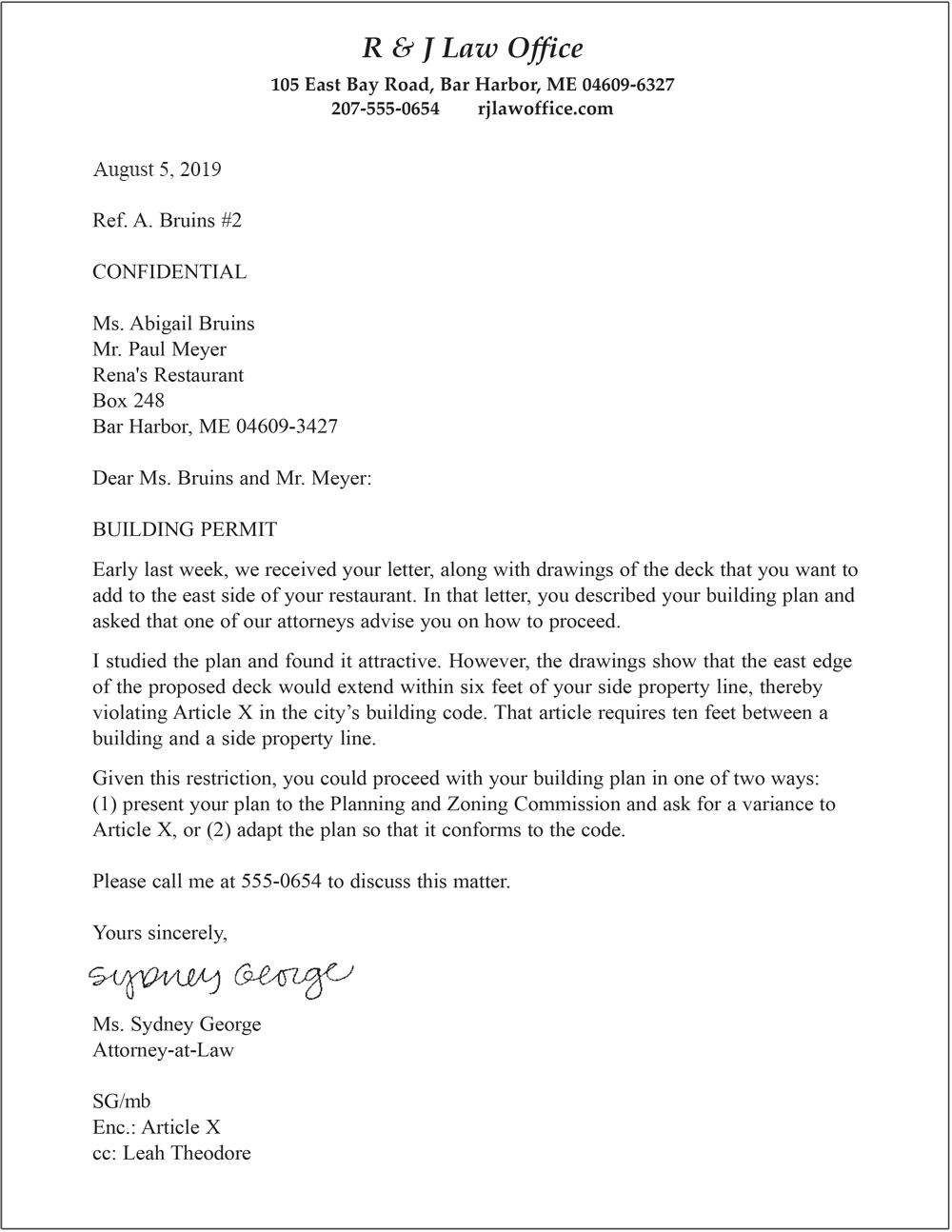
Semiblock
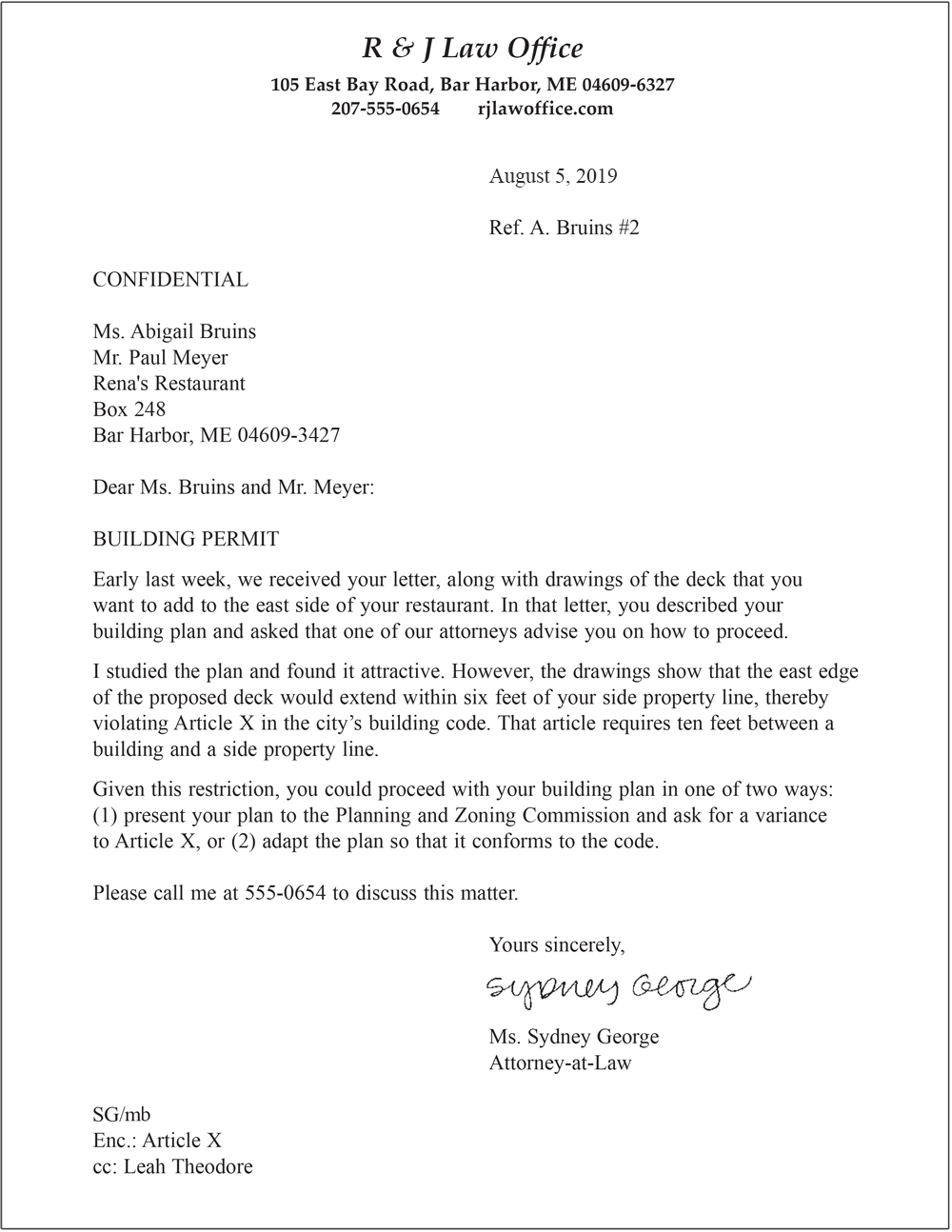
Simplified
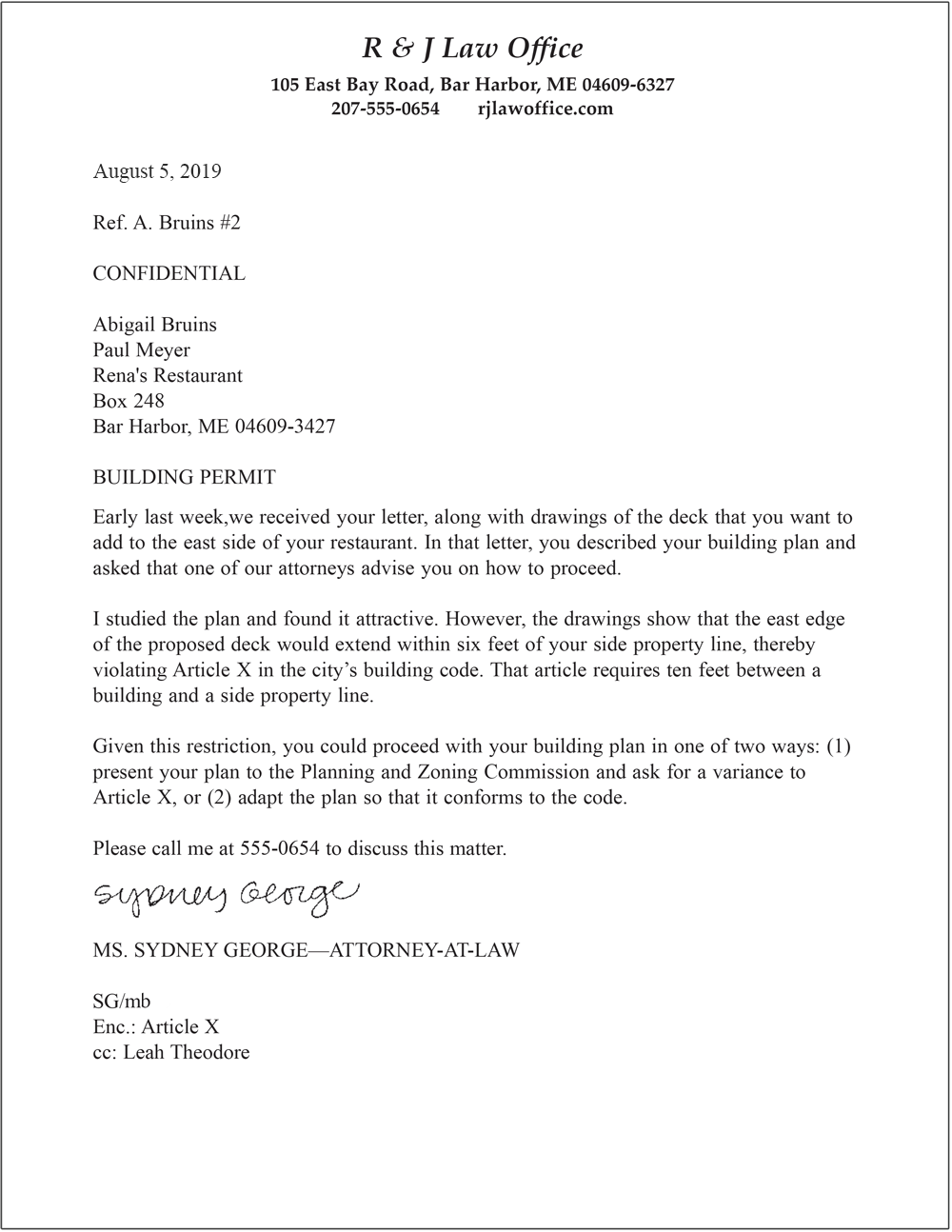
Letters and Envelopes
Folding Letters
A Standard Fold: To put a letter in its matching envelope, place the letter face-up and follow these steps:
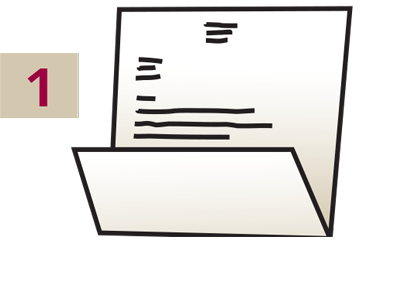
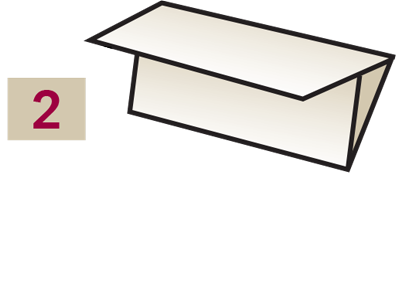

-
Fold the bottom edge up so that the paper is divided into thirds. Use your thumbnail to create a clean crease.
-
Fold the top third down over the bottom third, leaving 1/4 inch for easy unfolding, and crease firmly.
-
Insert the letter (with the open end at the top) into the envelope.
A Large Sheet in a Small Envelope: If you must place a letter in a small envelope, follow these steps:
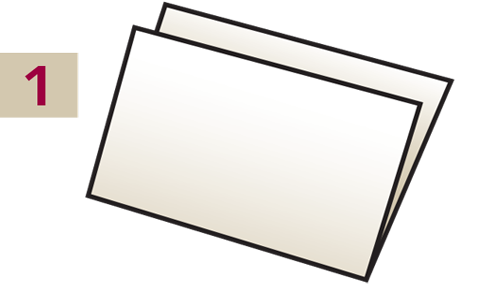
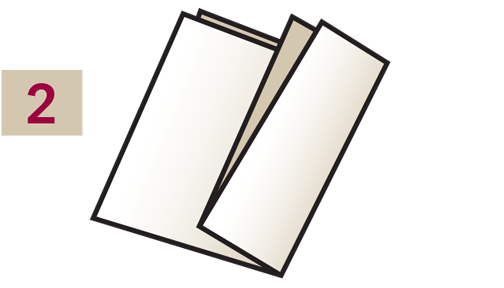
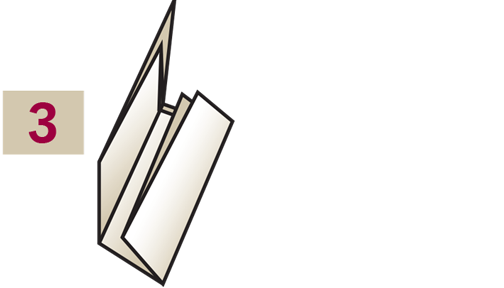

-
Fold the bottom edge up so that the paper is divided in half, and create a clean crease.
-
Fold the right side to the left so that the sheet is divided into thirds; crease firmly.
-
Fold the left third over the right third and crease firmly.
-
Turn the letter sideways and insert it (with the open end at the top) into the envelope.
A Window Envelope: Position the inside address on the letter so that it will show through the window. Then place the letter face up and fold it as follows:
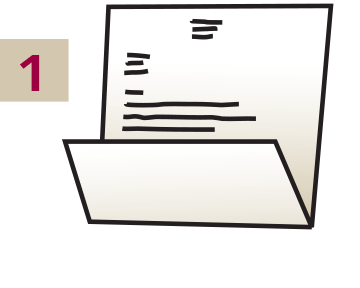
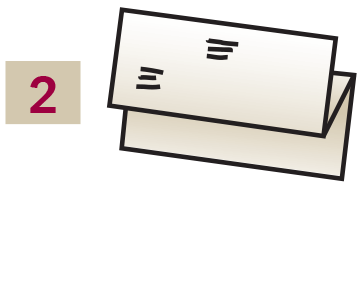

-
Fold the bottom edge up so that the paper is divided into thirds, and create a clean crease.
-
Turn the letter face-down with the top edge toward you and fold the top third of the letter back.
-
Insert the letter in the envelope and make sure that the whole address shows through the window.
U.S. Postal Service (USPS) Envelope Guidelines
To be sure that your letters are delivered quickly and correctly, follow all United States Postal Service (USPS) guidelines when you address an envelope. See the envelope and helpful guidelines below.
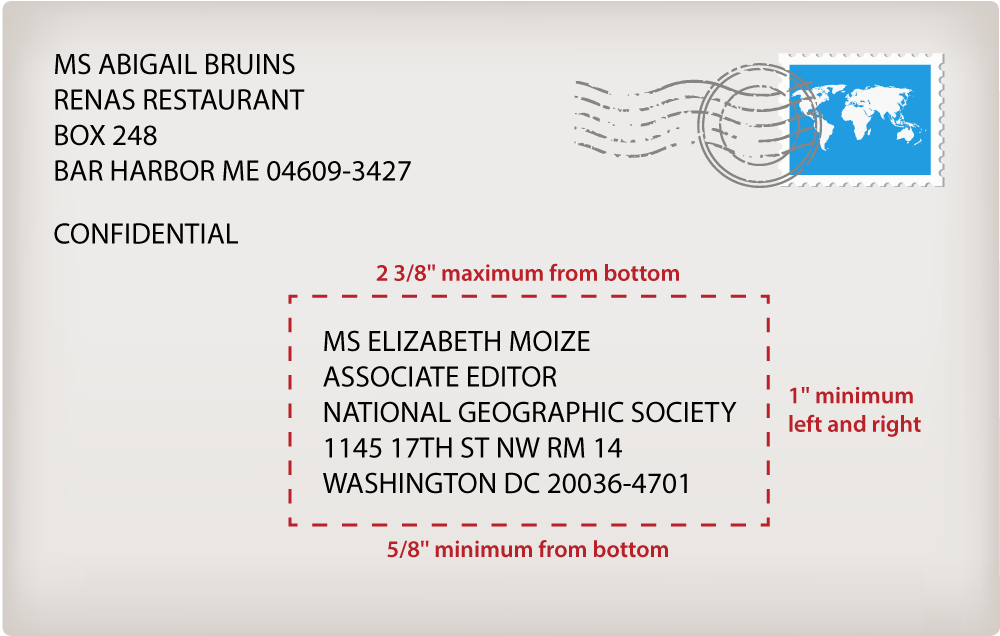
-
Type the receiver’s name and address in black ink on a light-colored envelope. Use an all-cap style for everything in the address. Make sure all lines are horizontal and lined up flush left. Leave out all punctuation except the hyphen in the zip code.
-
Type the receiver’s address—including the type of street (ST, AVE), compass points (NE, SW), and full ZIP code—in the order pictured. Place the suite, room, or apartment number on the address line, after the street address.
-
Use USPS abbreviations for states and other words in the address. Use numerals rather than words for numbered streets (9TH AVE). Add ZIP+4 codes. (Go to www.usps.com to get the ZIP code for any street address in the country.)
Tips for International Mail
When sending international mail, print the country name alone on the last line. As long as the country, city, and state or province are in English, the name and address may be in the language of the country listed.
Pattern:
Name of Receiver
Street Address or PO Box
City, State/Province, Code
Country (Caps, English)
Examples:
MR BRUCE WARNER
2431 EDEN WAY
LONDON W1P 4HQ
ENGLAND
MS TAMARA BEALS
56 METCALFE CRES
MONTREAL QC J7V 8P2
CANADA
Standard Postal Abbreviations
States, Provinces, and Territories
U.S. States
Alabama |
AL |
Alaska |
AK |
Arizona |
AZ |
Arkansas |
AR |
California |
CA |
Colorado |
CO |
Connecticut |
CT |
Delaware |
DE |
District of Columbia |
DC |
Florida |
FL |
Georgia |
GA |
Guam |
GU |
Hawaii |
HI |
Idaho |
ID |
Illinois |
IL |
Indiana |
IN |
Iowa |
IA |
Kansas |
KS |
Kentucky |
KY |
Louisiana |
LA |
Maine |
ME |
Maryland |
MD |
Massachusetts |
MA |
Michigan |
MI |
Minnesota |
MN |
Mississippi |
MS |
Missouri |
MO |
Montana |
MT |
Nebraska |
NE |
Nevada |
NV |
New Hampshire |
NH |
New Jersey |
NJ |
New Mexico |
NM |
New York |
NY |
North Carolina |
NC |
North Dakota |
ND |
Ohio |
OH |
Oklahoma |
OK |
Oregon |
OR |
Pennsylvania |
PA |
Puerto Rico |
PR |
Rhode Island |
RI |
South Carolina |
SC |
South Dakota |
SD |
Tennessee |
TN |
Texas |
TX |
Utah |
UT |
Vermont |
VT |
Virginia |
VA |
Virgin Islands |
VI |
Washington |
WA |
West Virginia |
WV |
Wisconsin |
WI |
Wyoming |
WY |
Canadian Provinces, Territories
Alberta |
AB |
British Columbia |
BC |
Manitoba |
MB |
New Brunswick |
NB |
Newfoundland and Labrador |
NL |
Northwest Territories |
NT |
Nova Scotia |
NS |
Nunavut |
NU |
Ontario |
ON |
Prince Edward Island |
PE |
Quebec |
QC |
Saskatchewan |
SK |
Yukon Territory |
YT |
Abbreviations for Use on Envelopes
Annex |
ANX |
Apartment |
APT |
Avenue |
AVE |
Boulevard |
BLVD |
Building |
BLDG |
Causeway |
CSWY |
Circle |
CIR |
Court |
CT |
Drive |
DR |
East |
E |
Expressway |
EXPY |
Floor |
FL |
Fort |
FT |
Freeway |
FWY |
Harbor |
HBR |
Heights |
HTS |
Highway |
HWY |
Hospital |
HOSP |
Junction |
JCT |
Lake |
LK |
Lakes |
LKS |
Lane |
LN |
Meadows |
MDWS |
North |
N |
Northeast |
NE |
Northwest |
NW |
Office |
OFC |
Palms |
PLMS |
Park |
PARK |
Parkway |
PKWY |
Place |
PL |
Plaza |
PLZ |
Port |
PRT |
Post Office Box |
PO BOX |
Ridge |
RDG |
River |
RIV |
Road |
RD |
Room |
RM |
Route |
RTE |
Rural |
R |
Rural Route |
RR |
Shore |
SH |
South |
S |
Southeast |
SE |
Southwest |
SW |
Square |
SQ |
Station |
STA |
Street |
ST |
Suite |
STE |
Terrace |
TER |
Throughway |
TRWY |
Turnpike |
TPKE |
Union |
UN |
Viaduct |
VIA |
View |
VW |
Village |
VLG |
West |
W |
For mass mailings and other specialized business services, go to www.usps.com.
Faxing Documents
Faxing may still play a key role when official signatures are needed on paper documents, for example with legal, medical, or government communications. When sending a fax, use your organization’s cover sheet. If no cover sheet is available, create your own using some or all of the items below. (Most word-processing programs include templates for cover sheets.)
The receiver’s name, title, company, phone number, and fax number To |
Mr. Vincent Malloy Meridian Management Consultants Phone: 702-555-3815 Fax: 702-555-3818 |
Your name, telephone number, and fax number From |
Elizabeth Hills Phone: 702-555-8100, ext. 3 Fax: 702-555-8155 |
The date Date |
February 12, 2019 |
Message: a subject line or brief direction Message |
Please review the following documents concerning your real estate transaction and call me. |
The number of pages sent Pages |
11 (including cover sheet) |
A trouble-shooting statement asking the receiver to call if a transmission problem occurs If you encounter any problems during transmission, please call 702-555-8100.
Important: This message is intended for the use of only the individual or entity to which it is addressed. The message is confidential and protected under applicable law, and any distribution or copying of this document is prohibited. If you receive this document by mistake, please notify us by telephone and return the document to the above address through the U.S. Postal Service. Thank you.
Forms of Address
Usually, you can rely on common sense to tell you how to address your reader with respect. When you’re unsure, use the guidelines below and on the following pages to find a fitting title, salutation, and complimentary closing.
Professional Titles
Professional Titles
-
Avoid writing to positions, titles, or departments. Call the organization (or visit its website) for names.
-
Spell out all professional titles except Dr.
-
Avoid using two professional titles that mean the same thing: Dr. Paula Felch, M.D.
Business
Titles in Address |
Salutations |
|
CEO |
Ms. Sarah Falwell, Chief Executive Officer |
Dear Ms. Falwell: |
Vice President |
Dr. David Levengood, Vice President |
Dear Dr. Levengood: |
Company Official |
Ms. Susan Cook, Comptroller |
Dear Ms. Cook: |
Education
Titles in Address |
Salutations |
|
President or Chancellor of University (Ph.D.) |
Dr. Joe Smith, President |
Dear Dr. Smith: (or) Dear President Smith: |
Dean of a School or College (Ph.D.) |
Dr. Marjorie Stone, Dean School of Life Sciences |
Dear Dr. Stone: (or) Dear Dean Stone: |
Professor (Ph.D.) |
Dr. Patricia Monk, Professor of Psychology |
Dear Dr. Monk: (or) Dear Professor Monk: |
Instructor (no Ph.D.) |
Mr. Art Linkman, Instructor of Physics |
Dear Mr. Linkman: |
Legal
Titles in Address |
Salutations |
|
Lawyer |
Mr. Daniel Walker, Attorney-at-Law |
Dear Mr. Walker: |
Daniel Walker, Esq. |
Dear Daniel Walker, Esq.: |
Medical
Titles in Address |
Salutations |
|
Physician |
Dr. Sarah McDonald Sarah McDonald, M.D. |
Dear Dr. McDonald: |
Registered Nurse |
Nurse John Seguin John Seguin, R.N. |
Dear Nurse Seguin: |
Dentist |
Dr. Leslie Matheson Leslie Matheson, D.D.S. |
Dear Dr. Matheson: |
Veterinarian |
Dr. Manuel Ortega Manuel Ortega, D.V.M. |
Dear Dr. Ortega: |
Courtesy Titles
-
Choose “standard” or “formal” titles and salutations based on your relationship with the reader and the seriousness of the message.
-
Abbreviate all courtesy titles: Mr., Ms., Mrs.
-
Never guess your reader’s gender (Robin, Pat, Chris).
-
Use a woman’s preferred courtesy title: Ms., Miss, or Mrs.
-
Use a woman’s preferred name: original, married, or combined (Smith-Olsen).
One Woman (avoid showing marital status)
Titles in Address |
Salutations |
|
Preferred |
Ms. Barbara Jordan |
Dear Ms. Jordan: |
Married or Widowed |
Mrs. Lorene Frost |
Dear Mrs. Frost: |
Single |
Ms. Adriana Langille |
Dear Ms. Langille: |
Two or More Women (alphabetical)
Titles in Address |
Salutations |
|
Standard |
Ms. Bethany Jergens Ms. Shavonn Mitchell |
Dear Ms. Jergens and Ms. Mitchell: |
Formal |
Mmes. Bethany Jergens and Shavonn Mitchell |
Dear Mmes. Jergens and Mitchell: |
One Man
Titles in Address |
Salutations |
|
Standard |
Mr. Hugh Knight |
Dear Mr. Knight: |
With Jr., Sr., or Roman Numeral |
Mr. Brian Boswell, Jr. Mr. Brian Boswell III |
Dear Mr. Boswell: |
Two or More Men (alphabetical)
Titles in Address |
Salutations |
|
Standard |
Mr. Alex Fernandez Mr. Nate Shaw |
Dear Mr. Fernandez and Mr. Shaw: |
Formal |
Messrs. Alex Fernandez and Nate Shaw |
Dear Messrs. Fernandez and Shaw: |
One Man and One Woman (alphabetical)
Titles in Address |
Salutations |
|
Ms. Paula Trunhope Mr. Joe Williams |
Dear Ms. Trunhope and Mr. Williams: |
Married Couple
Titles in Address |
Salutations |
|
Same Last Name |
Mr. William and Mrs. Susan Lui |
Dear Mr. and Mrs. Lui: |
Different Last Names |
Mr. William Bentley Ms. Sinead Sweeney |
Dear Mr. Bentley and Ms. Sweeney: |
One Reader (gender unknown)
Titles in Address |
Salutations |
|
M. Robin Leeds Robin Leeds |
Dear M. Leeds: Dear Robin Leeds: |
Mixed Group
Titles in Address |
Salutations |
|
Company, Department, Job Title, or Unknown Reader |
Acme Corporation Human Resources Dept. |
Formal Dear Sir or Madam: Informal Dear Manager: |
Government Officials and Representatives
To properly address government officials (national, state, local, judicial, and so on), follow this pattern:
Title in Inside Address: |
The Honorable (full name) |
Formal Salutation: |
Dear Sir/Madam: or |
Informal Salutation: |
Dear Mr./Ms. (last name): or |
Official Titles
-
Use a formal title (Senator, General) rather than a standard courtesy title (Mr., Ms.).
-
Avoid outdated courtesy forms (Gentlemen, To Whom It May Concern).
National
Titles in Address |
Salutations |
|
President |
The President |
Dear Mr./Madam President: |
Vice President |
The Vice President |
Dear Mr./Madam Vice President: |
Speaker of the House |
The Honorable Steven Kudo |
Dear Mr. Speaker: |
Cabinet Members, Undersecretaries, etc. |
The Honorable Jane Doe |
Dear Madam: Dear Attorney General Doe: |
Senators (U.S. or State) |
The Honorable Bill Johnson |
Dear Senator Johnson: |
Representatives (U.S. or State) |
The Honorable Joan Walker |
Dear Ms. Walker: Dear Representative Walker: |
Heads of Offices and Agencies |
The Honorable John Hillman Postmaster General |
Dear Mr. Postmaster General: Dear Mr. Hillman: |
Chief Justice (U.S. or State) |
The Honorable Shelby Woo Chief Justice of California |
Dear Madam Chief Justice: |
U.S. Ambassador |
The Honorable Francis del Verda |
Dear Mr. Ambassador: Dear Ambassador del Verda: |
State/Local
Titles in Address |
Salutations |
|
Governor |
The Honorable Mary Lee |
Dear Governor Lee: |
Mayor |
The Honorable Mark Barne |
Dear Mayor Barne: |
Council Member |
The Honorable Corey Springs |
Dear Mr. Springs: |
Judge |
The Honorable Grace Kim |
Dear Judge Kim: |
Military
Titles in Address |
Salutations |
|
General |
Major General Karl P. Bastion, USAF |
Sir: (formal) Dear General Bastion: |
Lieutenant |
Lieutenant Jane Evans, USMC |
Dear Ms. Evans: |
Religious Titles
To address religious leaders from any faith with titles that fit their positions, follow these guidelines.
Religious Titles
-
The use of The before Reverend differs from church to church. Follow the organization’s preference.
-
In some religious orders, the title in the salutation is followed by the reader’s first name. Other orders prefer the last name.
-
If the person has a Doctor of Divinity degree, add a comma and D.D. after his or her name in the address (not the salutation).
Roman Catholic Clergy
Titles in Address |
Salutations |
|
Cardinal |
His Eminence, Edward Cardinal Romero |
Your Eminence: Dear Cardinal Romero: |
Archbishop and Bishop |
The Most Reverend Henri Crétien |
Your Excellency: Dear Bishop/Archbishop Crétien: |
Priest |
The Reverend Morris Franklin |
Reverend Sir: Dear Father Franklin: |
Nun |
Sister Mary Jennsen |
Dear Sister Mary: Dear Sister Jennsen: |
Monk |
Brother Atticus Bartholemew |
Dear Brother Atticus: Dear Brother Bartholemew: |
Protestant Clergy
Titles in Address |
Salutations |
|
Bishop (Anglican, Episcopal, Methodist) |
The Right Reverend Samuel Wolfe |
Right Reverend Sir: Reverend Sir: Dear Bishop Wolfe: |
Dean (Head of Cathedral or Seminary) |
The Very Reverend Nicholas Cameron |
Very Reverend Sir: Dear Dean Cameron: |
Minister or Priest |
The Reverend Susan Edwards |
Dear Reverend Edwards: Pastor Edwards Dear Pastor Edwards: |
Chaplain |
Chaplain Adam Carp Captain, USMC |
Dear Chaplain Carp: |
Jewish Clergy
Titles in Address |
Salutations |
|
Rabbi |
Rabbi Joshua Gould |
Dear Rabbi Gould: |
Rabbi with Doctor of Divinity Degree |
Rabbi Joshua Gould, D.D. |
Dear Dr. Gould: |
Guidelines Writing Memos
Your goal is to make your point quickly, clearly, and effectively. If possible, keep your memo to a single page.
-
Plan: (Ideas and Organization)
-
Ask yourself why you are writing. What outcome do you want?
-
Consider your readers. Who needs this memo? Why? How should the memo be sent?
Prepare to draft. Gather necessary facts, figures, and attachments. Brainstorm for more details and make a list of your main points.
-
Draft: (Ideas, Organization, and Voice)
Opening Type “memo” or “memorandum” at the top of the page and complete the memo heading (name only one subject on the subject line).
Middle Provide details that answer readers’ questions: What is this memo about? What does it mean to me? Why is it important?
Closing Clarify any action needed, especially who is responsible for what.
Note: If your message is informative, put your key point in the subject line and introduction. For bad-news or persuasive memos, use a neutral subject line and then build to your main point.
-
Revise: (Ideas, Organization, Voice, Words, and Sentences)
-
Have you given clear, accurate information?
-
Have you arranged your points logically?
-
Have you used a team attitude, focusing on company goals?
-
Have you used a polite, professional voice?
-
Have you used precise word choice, smooth sentences, and effective transitions?
-
-
Edit: (Conventions and Design)
-
Have you checked punctuation, capitalization, usage, and grammar?
-
Have you checked for a reader-friendly format and design that uses lists, headings, tables, boxes, and white space effectively?
-
“I have received memos so swollen with managerial babble that they struck me as the literary equivalent of assault with a deadly weapon.”
—Peter Baida
Writing Basic Memos
Center “Memorandum,” or company name. Memo
Complete and align all four items in the heading. Initial or sign paper memos. Date: |
August 9, 2019 |
To: |
Josie James |
Single- or double-space the heading.
From: |
Ike Harris |
Type “Subject” or “Re” and state your subject as a summary of your message. Subject: |
Promotion of Mona Veal to Full-Time Graphic Artist |
Triple Space
Opening: Expand on the subject line. For the past 18 months, Mona Veal has done outstanding work as a part-time graphic artist in our Marketing Department. I recommend that she be promoted to full-time status and be given the necessary $2.50 per hour wage increase and full benefits.
Double Space
The promotion is warranted for two reasons:
-
Middle: Where appropriate, use lists for easy reading. Throughout the past 18 months, Mona has demonstrated those traits that Slenk Manufacturing most values in its graphic artists: creativity, dependability, and the ability to work well with others.
-
Double-space between paragraphs and items in a list. Presently we have four full-time and two part-time graphic artists. While this group was able to complete its projects on time last year, Allison Christian in Accounting tells me that the full-time employees averaged 3.5 hours of overtime per week throughout the year. Given that fact, our new contract with LEE-MAR Industries will soon put a strain on both the group and our budget.
Closing: Focus on action. Please let me know by August 16 whether you approve this promotion. I’d like Mona to begin full-time work on September 1.
Use 1" to 1.5" margins and a block style.
Parts of an Expanded Memo
While each memo includes the basic elements, sometimes you may need to add more elements. The guidelines and models below show your options.
Heading
-
You can type “Memo,” “Memorandum,” or the company name at the top, but do not include the company’s address or phone number.
-
For sensitive messages, label your memo confidential and seal it in an envelope that is also marked confidential.
-
Complete your heading with job titles, phone numbers, email addresses, or a checklist showing the memo’s purpose. In a paper memo, handwrite your initials after your name in the heading or after your job title, if one is used. If you have more than one reader, use one of these options:
-
List the names after To: and highlight a different one on each copy of the memo.
-
Put See distribution after To: and list all the readers at the end of the memo.
-
Type a department’s name after To:
-
Closing
-
Use quick-response options such as checklists, fill-in-the-blanks, or boxes.
-
Add an identification line showing the writer’s initials (in caps) and the typist’s initials (in lowercase) separated by a slash.
-
If you’re sending documents with the memo, type Attachment(s) or Enclosure(s), followed by either (a) the number of documents or (b) a colon and the document titles listed vertically.
-
If you want to send copies to secondary readers, type c (copy) or cc (courtesy copy) and a colon; then list the names and job titles stacked vertically (when job titles are included). To send a copy to someone without the main reader knowing it, add bc (blind copy) ONLY on the copy sent to the person listed after the bc notation.
If your memo is longer than one page, carry over at least two lines of the message onto a plain sheet of stationery. Use one of the heading formats shown.
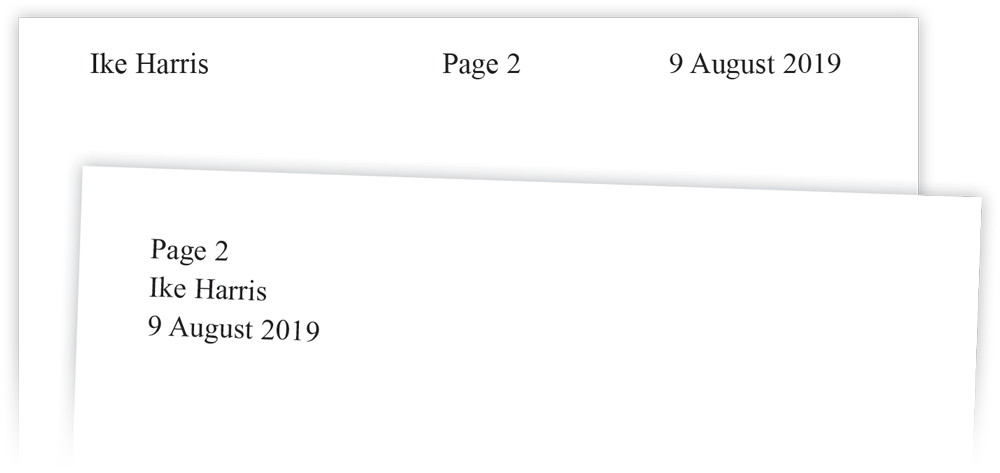
Writing Expanded Memos
Slenk Manufacturing
C O N F I D E N T I A L
Date: |
August 9, 2019 |
To: |
Josie James, Director of Personnel Rebecca Tash, LAHW Representative |
From: |
Ike Harris, Graphic Arts Director |
Subject: |
Promotion of Mona Veal to Full-Time Graphic Artist |
For the past 18 months, Mona Veal has done outstanding work as a part-time graphic artist in our Marketing Department. I recommend that she be promoted to full-time statusand be given the necessary $5.50 per hour wage increase and full benefits. The promotion is warranted for two reasons:
-
Throughout the past 18 months, Mona has demonstrated those traits that Slenk Manufacturing most values in its graphic artists: creativity, dependability, and the ability to work well with others.
-
Presently we have four full-time and two part-time graphic artists. While this group was able to complete its projects on time last year, Allison Christian in Accounting tells me that the full-time employees averaged 3.5 hours of overtime per week throughout the year. Given that fact, our new contract with LEE-MAR Industries will soon put a strain on both the group and our budget.
If you approve the promotion, please initial below and return this memo.
Yes, proceed with Mona Veal’s promotion to full-time graphic artist. ____
IH/gm
Attachment: Evaluation report of Mona Veal
c: Elizabeth Henry
Mark Zoe
Checklist Writing Letters, Faxes, and Memos
Your goal is to create a letter, fax, or memo that clearly communicates your message.
My writing . . .
-
is strong, clear, and accurate.
-
has answered the reader’s questions: Why are you writing me? What needs to be done?
-
-
is appropriately direct or indirect, based on the reader’s likely response.
-
contains an informative subject line (if needed).
-
follows a fitting opening, middle, and closing structure.
-
-
is courteous throughout, from salutation to complimentary closing.
-
uses an appropriate voice and focuses on the reader’s needs.
-
-
uses plain English—precise, clear, and simple words.
-
uses names and personal pronouns, especially “you,” effectively.
-
-
has short- to medium-length sentences that pass the “read aloud” test.
-
uses transition words to link ideas.
-
-
follows all punctuation and capitalization rules for memos and letters.
-
uses correct abbreviations, titles, and spelling throughout.
-
contains no errors in grammar or keyboarding.
-
-
follows all the rules of the format—spacing, margins, alignment, and so on.
-
contains short paragraphs.
-
uses headings and bulleted or numbered lists wherever helpful.
-
has a polished look—white space, clean typography, and good stationery.
-
includes initials, signatures, and attachments, if appropriate.
-
“I have made this [letter] longer, because I have not had the time to make it shorter.”
—Blaise Pascal

